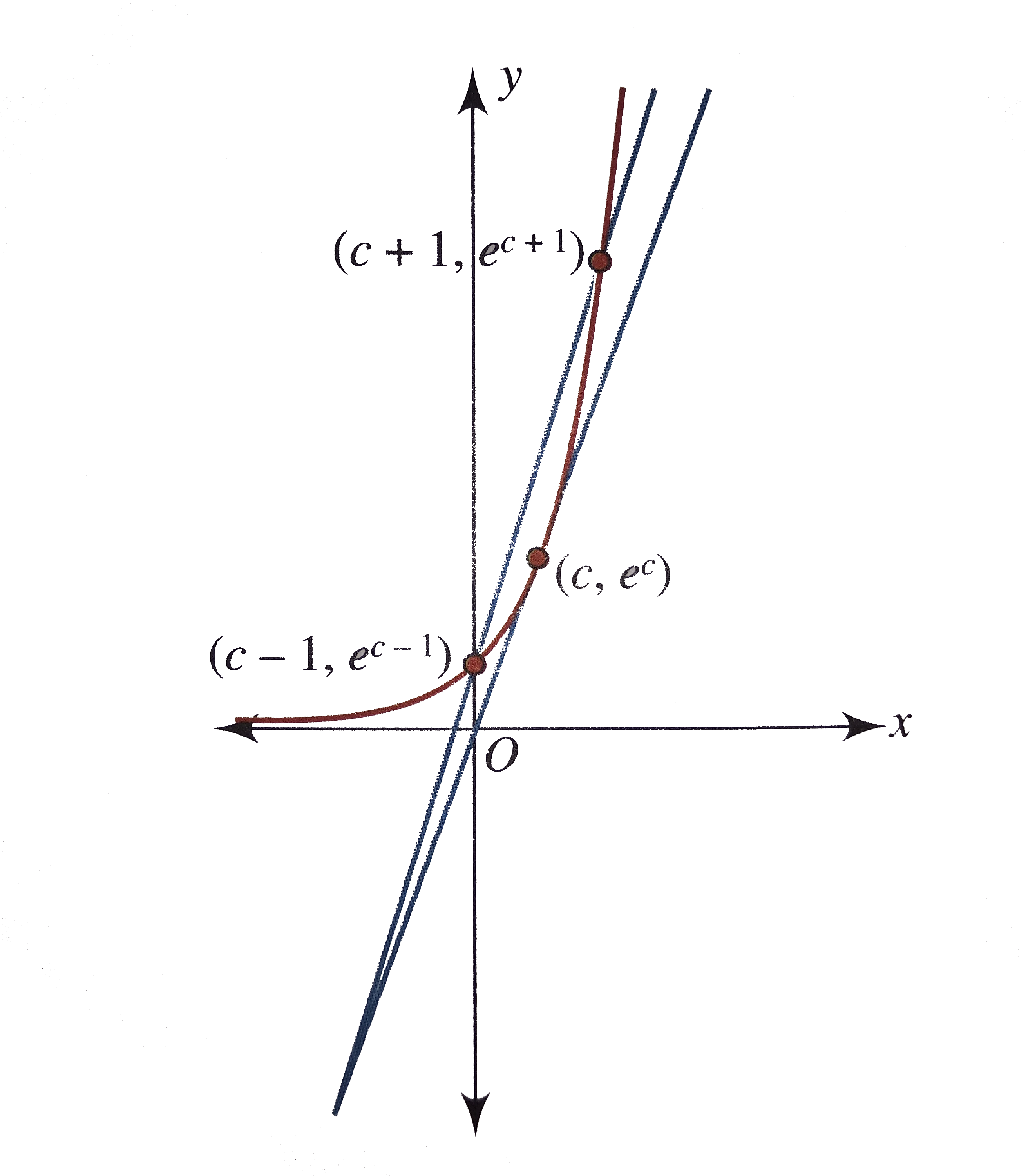about to only mathematics The tangent to the curve y=e^x drawn at the point (c,e^c ) intersects the line joining the points (c−1,e^(c−1) ) and (c+1,e^(c+1) )Solution in Bengali
On the left of x=c
On the right of x=c
At no point
At all points
Slope of the tangent to y=ex at (c,ec) is given by
m1=(dydx)(c,ec)=ec
Therefore, the equation of the tangent at (1,e) is
y−e=e(x−1)
Also the slope of the line joining the points (c−1,ec−1)and(c+1,ec+1) is
m2=ec+1−ec−1(c+1)−(c−1)
=ec+1−ec−12
=ec(e−e−12)
We observe m2>m1
Thus, the tangent to the curve y=ex will intersect the given line to the left of the line x=c as shown in the following figure.
Hence the correct answer is (a).

Topper's Solved these Questions
- GRAPHS OF ELEMENTARY FUNCTIONS Book:CENGAGE PUBLICATIONChapter:GRAPHS OF ELEMENTARY FUNCTIONS Exercise:EXERCISES
Explore 33 Videos
- GRAPHS OF POLYNOMIAL AND RATIONAL FUNCTIONSBook:CENGAGE PUBLICATIONChapter:GRAPHS OF POLYNOMIAL AND RATIONAL FUNCTIONSExercise:Exercises
Explore 16 Videos
- GRAPHS OF TRIGONOMETRIC FUNCTIONSBook:CENGAGE PUBLICATIONChapter:GRAPHS OF TRIGONOMETRIC FUNCTIONSExercise:Exercises
Explore 22 Videos
Similar Questions
Draw the graph of y=1(1/x).
View SolutionDraw the graph of y=(x−1)(x2−x+1).
View SolutionDraw the graph of y= cosec 2x−cot2x. Is f(x) periodic ? If yes, what is its fundamental period ?
View SolutionThe tangent to the curve y=e^(x) drawn at the point (c,e^(c)) intersects the line joining (c-1,e^(c-1)) and (c+1,e^(c+1))( a) on the left of n=c( b) on the right of n=c(c) at no points ( d ) at all points
View SolutionWhen the tangent to the curve y=xlogx is parallel to the chord joining the points (1, 0) and (e, e) , the value of x is e1/1−e (b) e(e−1)(2e−1) (c) e2e−1e−1 (d) e−1e
View Solution∫2(ex+e−x)2 dx e−xex+e−x+C (b) −1ex+e−x+C (c) −1(ex+1)2+C (d) 1ex−e−x+C
View SolutionThe solution of the equation (ex+1)ydy+(y+1)dx=0, is (A) ex+y=C(y+1)ex (B) ex+y=C(x+1)(y+1) (C) ex+y=C(y+1)(1+ex) (D) exy=C(x+y)(ex+1)
View Solutionवक्र y=ex के बिन्दु (c,ec) पर खींची गयी स्पर्श रेखा बिन्दुओं (c−1,ec−1) व (c+1,ec+1) को प्रतिच्छेदित करती है -
View Solutionसिद्ध कीजिये कि बिन्दु (c,ec) से वक्र y=ex से खींची गयी स्पर्शी बिन्दुओं (c−1,ec−1) तथा (c+1,ec+1) को मिलाने वाली रेखा को x≤c पर प्रतिच्छेद करती है |
View Solution(ey+1)cosxdx+eysinxdy=0
View Solutionवक्र y=ex के बिन्दु (c,ec) पर खींची गयी स्पर्श रेखा बिन्दुओं (c−1,ec−1) व (c+1,ec+1) को प्रतिच्छेदित करती है -
View SolutionIf the tangent to the curve y=ex at a point (c,ec) and the normal to the parabola, y2=4x at the point (1,2) intersect at the same point on the x-axis then the value of c is ____________.
View SolutionIf the tangent to the curve , y =f (x)= xlogex,(x>0) at a point (c, f(c)) is parallel to the line - segment joining the point (1,0) and (e,e) then c is equal to :
View SolutionIf f(x)=logx satisfies Lagrange's theorem on [1,e] then value of c∈(1,e) such that the tangent at c is parallel to line joining (1,f(1)) and (e,f(e)) is
View SolutionThe tangent to the curve y=ex drawn at the point (c,ec) intersects the line joining (c−1,ec−1)and(c+1,ec+1) (a) on the left of n=c (b) on the right of n=c (c) at no points (d) at all points
View SolutionABC is a triangle. D is a point on AB such that AD=14AB and E is a point on AC such that AE=14AC. Prove that DE=14BC
View Solution
